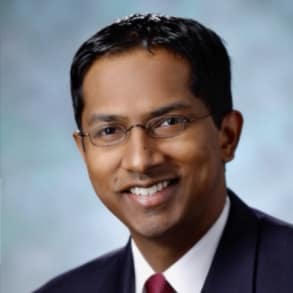Dr. Uma Srikumaran discusses his research comparing an anchored rotator cuff repair with an anchorless or transosseous approach. This is a cohort analysis comparing clinical and patient reported outcomes, structural integrity and costs.
Biomechanics, clinical outcomes and cost-effectiveness of arthroscopic, anchorless, transosseous rotator cuff repair.
Rotator cuff injuries are among the most common musculoskeletal injuries in the U.S, with more than 4.5 million physician visits and nearly 300,000 surgeries each year. These injuries are not only common, but they also exert a sizeable effect on patient quality of life. Moreover, at a cost of roughly $12,000 to $15,000 per rotator cuff repair, the total societal burden is significant—almost $4B. With the increase in rotator cuff surgeries in the last two decades, this problem is expected to grow.
Although the open transosseous technique was the original gold standard for rotator cuff repair, recent advances in arthroscopic surgery have given rise to a less-invasive procedure, with decreased deltoid muscle morbidity and a comparable rate of healing. In order to mimic the biomechanics of the older, time-tested technique and improve surgical outcomes with this newer approach, several anchor and suture configurations have been pioneered. At the same time, advances in surgical instrumentation have also made possible anchorless methods, which combine the advantages of open transosseous repair with those of the arthroscopic technique.
Direct comparisons of arthroscopic anchored and anchorless repair
Importantly, there are no published data that directly compare arthroscopic anchorless, transosseous repair with standard arthroscopic, anchored techniques. To address this gap in knowledge, Johns Hopkins orthopaedic surgeon Uma Srikumaran, MD, MBA, , has led two key
studies (manuscripts in preparation):
(1) A biomechanical analysis of 20 fresh-frozen human cadaveric shoulders, subjected to rotator cuff tears and then surgically repaired, to evaluate cyclic loading and ultimate load to failure, including mechanism of failure, in anchored (transosseous-equivalent, double row) versus anchorless (two-tunnel) repair.
(2) A retrospective case-control study of arthroscopic rotator cuff repair that compares anchorless, transosseus repair with anchored (double row) repair, assessing pain, range of motion, Subjective Shoulder Value (SSV) scores, ASES scores, Western Ontario Rotator Cuff Index (WORC) scores, operative time, structural integrity with ultrasound at one year, and recorded complications in a total of 102 patients.
The biomechanical study revealed that the anchored approach has a significantly higher ultimate failure load than the anchorless approach, and significantly less first-cycle excursion. There were no significant differences in failure load or gap formation during cyclic loading. Importantly, the primary modes of failure were type 2 tendon tears with medial tendon (muscle-tendon junction) disruption in the anchored group, and type 1 tendon tears with lateral tendon (bone-tendon interface) disruption in the anchorless group. Notably, the former failure mode is considered to be less favorable, due to the complexity of revision surgical repair.
Srikumaran’s clinical study revealed significant postoperative improvement in both the anchored and anchorless groups, as measured by pain, SSV and ASES score. Compared to the anchored group, the anchorless, transosseous group was found to have significantly larger tear size and higher age at the time of surgery. However, there were no significant differences between the two groups with respect to pain, ASES score, SSV, operating room time, procedural time, or structural integrity assessed by ultrasound at a minimum follow-up of one year.
Similar outcomes, but varying costs
The analyses by Srikumaran and his colleagues indicate that there are no significant differences between the anchored and anchorless arthroscopic techniques in terms of clinical outcomes, patient-reported outcomes, and structural integrity. Moreover, although the anchored method is superior in terms of biomechanical strength, it may predispose patients to secondary injuries that are less favorable and more difficult to repair surgically than the anchorless method. Finally, when considered in aggregate, the results of both studies suggest that anchorless, transosseous repair may provide a clinically optimal biomechanical strength even though it offers less absolute
strength when compared with anchored repair.
In the context of shifting health care models and the pressures to minimize costs, Srikumaran’s findings have important implications for the economics of rotator cuff repair. Considering the cost of a single anchor (ranging from $300 to $600) and the need for multiple anchors (often at least 4) to achieve an optimal repair, anchor repairs contribute significantly to the overall cost of care. Srikumaran and his team revealed that the transosseous approach can reduce implant costs by 30% to 80%, depending on tear size.
As the first comparative study of the traditional anchored technique for rotator cuff repair with the newer anchorless, transosseous technique, Srikumaran’s work provides preliminary evidence that the two methods are equivalent from a clinical standpoint, laying the foundation, both ethically and scientifically, for a randomized controlled trial.
References
1. Srikumaran U: Arthroscopic anchored vs. anchorless rotator cuff repair: comparison of outcomes and costs. Oral paper to be presented at the 2016 American Academy of Orthopaedic Surgeons Annual Meeting; March 2, 2016; Orlando, Fla.
2. Srikumaran U: Anchored versus anchorless rotator cuff repair: a biomechanical analysis. Oral paper to be presented at the 2016 American Academy of Orthopaedic Surgeons Annual Meeting; March 4, 2016; Orlando, Fla.
Related Presenters

Chair, Johns Hopkins Orthopaedic Surgery at Howard County General Hospital and Assistant Professor of Orthopaedic Surgery
Dr. Umasuthan Srikumaran is an assistant professor of orthopaedic surgery at the Johns Hopkins School of Medicine. Specializing in shoulder surgery, Dr. Srikumaran treats patients with shoulder pain, rotator cuff disease, traumatic injuries, ...
Related Videos